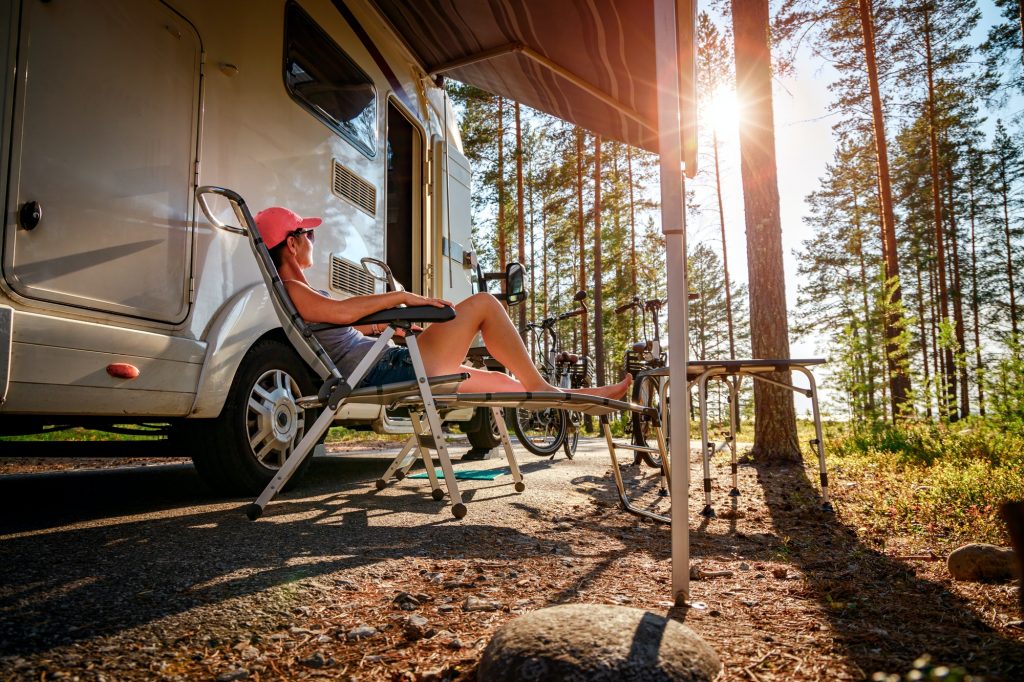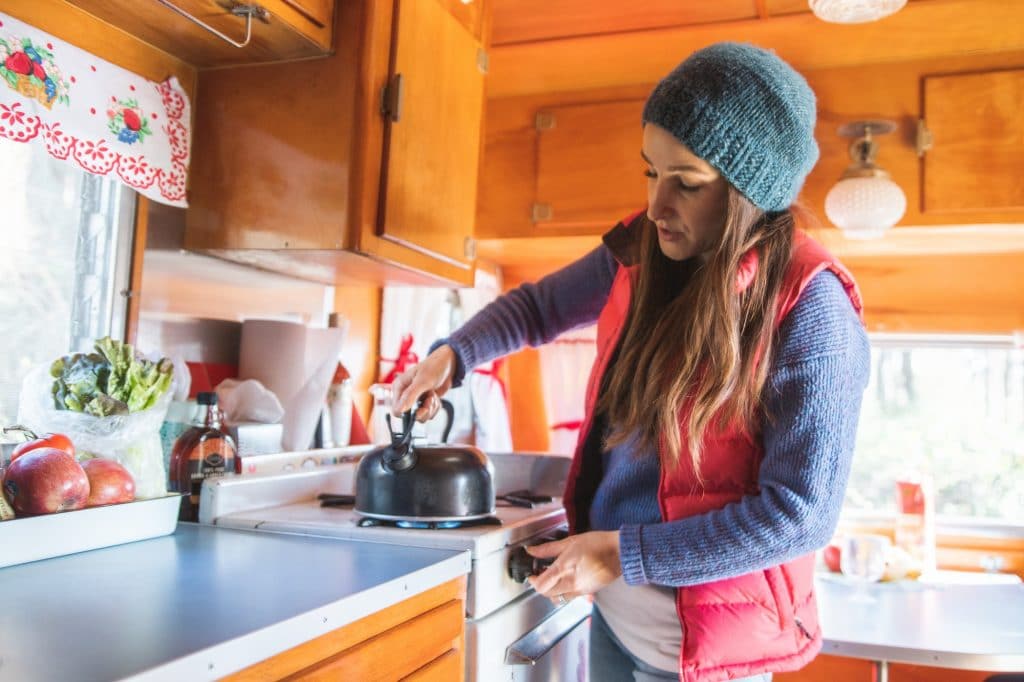It’s becoming increasingly expensive to rent an apartment in most cities around the world, and the requirements to actually stay in major cities has disappeared in the past few years for many people with work from home becoming a reality. The alternative could be to live in an RV and travel to any location you want for a fraction of the cost of renting.
Traveling and living in an RV gives you the ability to save more money and not be stuck in any one city. As long as you have access to an internet connection and phone or have a skill set that is highly desirable or needed then you can pick up work anywhere.
RV living is cheaper compared to renting an apartment. The average cost for RV living is between $500-$1000 and the cost of living in renting an apartment is between $1000-$1500.
The initial investment in an RV may be slightly higher, but the long-term cost savings are huge when you remove the need to pay ongoing rent which is money wasted at the end of the month. You can either buy a new RV or purchased a used RV that you can clean up and fix yourself before heading out on the road.
Whether you are single, a couple, or even a small family you will be able to save money by living in an RV.
It may seem a little scary at first wondering how in the world you would manage it. If you are struggling to afford rent this could be a game-changer for you and your family.
Selling off everything you own, buying an RV, and taking off. It really can be that easy. It can be terrifying to wonder where to start but it is a very simple life to live.
Now we will look at the breakdown of exactly why living in an RV will cost you less, tips to living small while still having a home that can function well, and saying goodbye to throwing away rent money for the rest of your life.
RV vs Apartment Cost Comparison

Here is the actual breakdown of the average cost of renting a home compared to living in an RV full time. These numbers are the average cost in the United States.
Some towns’ rent could be far higher or lower depending on where you live. RV cost is typically close to the same around the country as campgrounds are usually close to the same in every state, the view is simply different.
*Cost is the average for a couple living in a single-family home in the US and not an exact cost there are many variables that could easily change the price substantially*
| Utility | Rv Living Cost | Renting Cost |
| Monthly “Housing” | Free to $800 | $1000-$1500 |
| Electric | Usually Included | $120 |
| Water | Usually Included | $35 |
| Sewer Tank Dumping | Free to $8 | $15 |
| Trash Collection | Free to $15 | $18 |
| Food | $300 | $450 |
| Gas and Propane | $50 | $80 |
| Home and RV Insurance | $60 | $100 |
| Fuel and Oil (Driving) | $150 | $75 |
| Internet | Free to $50 | $50 |
| Laundry | $50 | $50 |
| Total Monthly Cost | $560 to $1,183 | $1000-$1500 |
- Housing –
- This all depends on where you are staying and what is included. There are also some campsites that are free at different times during the year.
- Electric –
- This is typically always included in the lot cost for the month.
- Water –
- Water hookup is also usually included in the lot cost for the month.
- Sewer Tank Dumping –
- This can be included or can cost you a few dollars to dump when your tank gets full.
- Some campsites have it set up so you hook up your tank when you pull up so it empties as its used.
- Trash Collection –
- Most sites have dumpsters and just include the few in with the monthly lot fee
- If there is a separate fee or you have excess trash you could pay a few dollars.
- Food –
- This is fairly self-explanatory. You will have a smaller fridge and cooking area than normal.
- Some people think this will make you spend more on food.
- It is actually the opposite; you will have less waste because you can only buy so much at a time.
- Propane –
- This will cost different for every family depending on how much you cook inside and shower.
- You can always cook over a campfire most nights and utilize shower houses to save money.
- Internet –
- Instead of spending a ton on a hotpot to take along, you can utilize the free Wi-Fi offered at almost every campground.
- If there aren’t wifi chances are there is no cell service so a hotspot would do no good anyway.
- Laundry –
- Some RVs have a small washer & dryer combo, some campsites have laundry mats
- Vehicle Cost –
- Insurance, maintenance, and gas are all costs you really can’t do anything about, unfortunately.
As you can see it is far cheaper to live in an RV. This chart does not include furnishing your home. It could cost $10,000 to buy everything when starting from scratch. RVs come furnished with just about everything you will need or items you already have.
Why People Choose RV Living

Paying rent is expensive and often you’re paying more than the owner of the apartment needs for their mortgage. So you’re investing in somebody else’s future rather than your own by renting and paying extreme prices to live in downtown locations or apartments and houses that restrict what you can and can’t do in them.
If you were to lower your living costs you would have more money to enjoy life, or you can start saving more for your own downpayment on an apartment or house so that you’re investing in your own financial freedom.
Why renting is sometimes a bad choice:
- Rent gives you a place to stay eahc month, but otherwise the money is wasted long-term.
- Having to worry about accidentally damaging something, keeping things perfect looking.
- You have limited housing security, as your owner can sell the apartment at any time leaving you to find somewhere new to live.
- You can never really make a rental living space your own, you are limited to what you can do to the living space.
- One word – Scumlords
- Yes, you are stationary but traveling/moving around has its perks.
- It is EXPENSIVE, homes just really should not be as much as they are to rent. Some landlords sadly take advantage of people.
There are many reasons why people decide to jump on the bandwagon and live small. Whether it is for the adventure, to save money, they are retired or they work around the country; every family has a reason to try out living small.
Many people are even selling their homes to live an RV life. No longer being tied down to one town.
While you can save quite a bit of money living in an RV there are also many luxury RVs and luxury campgrounds out there. So if you have the means to do so you technically could live a very luxurious life, on the road.
It is not the lifestyle for everyone though, and the decision should not be made lightly. Many families live simply fine in an RV and adapt very well. While some are just not able to handle the travel and confined spaces.
Before you make the leap make sure to have your family on board. Plan out what life could be life before taking the plunge. Once you sell everything you can’t just take it back if it isn’t for you. Try renting an RV for a week to see how you like it.
Living in RV Full Time
Now let’s look at the different ways to thrive living an RV lifestyle. Here is a great video on preparing to live full-time in an RV.
- Organization –
- The most important step to living smaller is being highly organized. You can’t expect to move from a traditional size home to an RV without it.
- Everything needs a place. This will be a game-changer.
- Utilize every space you can find and give every space a purpose.
- Know Where You Are Staying –
- Some campgrounds provide free electric, water, sewer even swimming, showers, and grills.
- There are thousands of wonderful campsites but you should also research before staying in an unknown place. There are many shady places out there that you would not want to stay let alone bring your family to.
- Enjoy Life –
- Soak in the time with your family. You may drive each other crazy but living the Rv life is an amazing way to become closer.
- Take the trips you always wanted to. You do not need to pack up and you always have a cheap place to stay.
Living in an RV can be a challenge but will typically always cost much less than renting a home. Some things you should keep in mind are:
- Renting a home can cost you around $2,000 more every month compared to living in an RV full time.
- Full-time RV living has grown widely popular in the last couple of decades.
- There is an RV for every budget and lifestyle out there.
- Almost every town in the United States has a campground. Some areas have many.
- Have a trial run before jumping right into the RV life.
- It is not for everyone but if you can learn to love the RV lifestyle you can save money and finally be able to enjoy the extras in life.
- If you decide to take the plunge have fun, take chances, and enjoy the ride.
RV Living FAQ Answered
Where do full time RVers stay?
Many full-time RVers live in RV parks or mobile home communities because they are designated for permanent living in RVs. Some stay on property they own that is located outside of city and county limits where the regulations do not apply, and full-time RV residence is allowed.
Is living in an RV considered homeless?
According to U.S. Code, RVs are temporary shelters not used for regular nighttime habitation so those living in them full-time can be considered legally homeless. However, this can vary somewhat based on the condition and location of the RV as well as access to resources to improve living conditions.
Can you claim an RV as a primary residence?
You can claim RV as your primary residence as IRS defines homes as “A house, condominium, cooperative, mobile home, house trailer, boat, or similar property that has sleeping, cooking, and toilet facilities.” RVs fall under the definition of the home if they include the listed facilities. This means an RV can be claimed as a primary residence.
How much does it cost to stay in an RV park for a month?
The cost of living in an RV park ranges from $500 to $1500 per month on average. Parks that include electricity, water, and septic services tend to be on the higher end. Some parks will offer discounts for permanent residents. There are also discounts for seniors, military, and veterans.
Sources:

Benjamin is a certified financial advisor, with over 10 years of experience in the industry. He is knowledgeable about various business and financial topics, such as retirement planning and investment management. Ben has been recognized for his work in the financial planning industry. He has also been featured in various publications.

